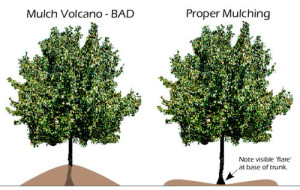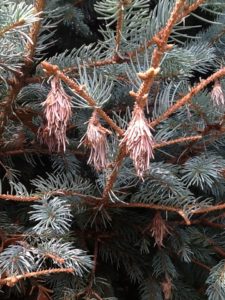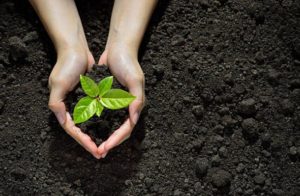As we hit mid-summer the hot days of July and August are looming ahead. Luckily we get to cool off in our air-conditioned homes, pools, and beach vacations but our trees never get a chance to escape the heat. As a homeowner, there are a few things you can do to help your tree get a break from the heat and stay healthy all summer.
Symptoms of Heat Stress In Trees:
When temperatures climb above 90 degrees tree start to show signs of summer heat stress.
- Drooping and wilting leaves and branches
- Yellowing or browning of trees leaves/needles
- Rust-colored spots or bumps
- Dropping leaves
 |
 |
How Can You Help Your Trees Beat The Heat?
1) Water A Lot But Not TOO Much.
In one day, a large tree can lift up to 100 gallons of water out of the ground if the water is available. And like humans, the hotter it is the more water trees and shrubs need. But overwatering can also have a negative effect on trees, essentially drowning their roots. Take a look at our tips below to make sure your tree is getting the right amount of water it needs to survive these heat waves

Watering Tips For Summer:
-
- Focus on the critical root zone when watering. Wetting foliage is a waste of water and can promote the spread of diseases.
- DON’T use a sprinkler. This only wets the top layer of soil and doesn’t properly water the tree.
- Water in the morning to avoid evaporation and to help trees deal with the heat throughout the day.
- Water deeply and thoroughly 1 to 2 times a week.
- Put your normal hose somewhere in the critical root zone.
- Turn hose on to a dribble
- Leave for 2-3 hours
- Move the hose to a different spot in the critical root zone and leave for 2-3 hours. Repeat this step 1-3 times.
- You want the soil to be moist but not soaking. You should NOT be able to make a mud ball out of the soil.
- It’s okay for some portions of the soil to be wet and some to be dry.
2) Mulch Your Tree
Mulching is one of the best techniques to protect your trees & shrubs from the heat. Mulch creates a layer of insulation that retains moisture and keeps the roots temperate.
Mulching Tips For Summer:
-
- Mulch 1 to 3 inches deep
- Keep the mulch from touching the trunk of the tree
- Spread mulch to a diameter of at least 3 feet
- Ideally, spread mulch out to the edge of the tree’s crown
- DO NOT CREATE A MULCH VOLCANO!

3) Monitor For Insects & Diseases
While your tree is busy trying to fight the summer heat, insects and diseases that are active in summer can target your tree. Because your tree is stressed from the heat it will have a harder time fighting off these insects and diseases and will most likely incur a lot of damage if you don’t step in.
Keep a close eye on your trees for signs of borers, spider mites, Japanese beetles, aphids, bagworms, and scale.
Common symptoms of summer insects/diseases to look out for include:
- defoliation
- drooping leaves
- yellow spots
- honeydew/sooty mold
- premature leaf drop
- twig dieback
- webbing
- cone-shaped brown bags hanging from trees
- cankers on tree trunks
4) Consider A Tree Growth Regulator

Tree growth regulators utilize three techniques to help make your tree drought resistant.
First, it gently slows the growth of the tree. Second, it develops thicker waxy cuticle (coating) & a thicker epidermis (skin) that is densely covered with fine hairs. These two techniques help reduce water loss in a tree. Lastly, it reallocates energy from new leaf growth to fine feeder root growth. This helps the tree absorb more water.
The tree growth regulator also allows you to prune less often and reduce costs related to watering and fertilizing. On the aesthetic side, the leaves of trees treated with tree growth regulator tend to be greener than untreated trees. One treatment will last up to 3 years.
5) Choose Drought Resistant Trees Next Time
If you’re planning to plant new trees this fall, look for drought-resistant species. This will help you save money on your watering bill while still allowing your tree to thrive in hot temperatures.

We recommend the following drought tolerant trees:
- ginko
- eastern redbud
- crepe myrtle
- elm
- hackberry
- hawthorn
- honey locust
- leyland cypress
- oak
- red maple
- sassafras
- sumac
 6) Schedule Your Fall Fertilization.
6) Schedule Your Fall Fertilization.
Once your fall comes your trees are going to be tired from battling the heat during the summer months. Providing your trees with Bio-stimulants will help them recover from the summer heat and prepare them for their long winter nap.
Think your tree has heat stress? Call one of our Certified Arborists 703-573-3029 or book an appointment online today.


